On June 25, 1950, the Korean War began when some 75,000 Soldiers from the North Korean People’s Army (NPKA) poured across the 38th parallel and, within days, captured Seoul, the South Korean capital. For two months, the outnumbered South Korean army and the small American force fought numerous battles with NPKA as they withdrew down the Korean peninsula to the Pusan area at the southeast tip of Korea. It was here that they set up a final defensive perimeter where they were able to impede the enemy’s advancement.
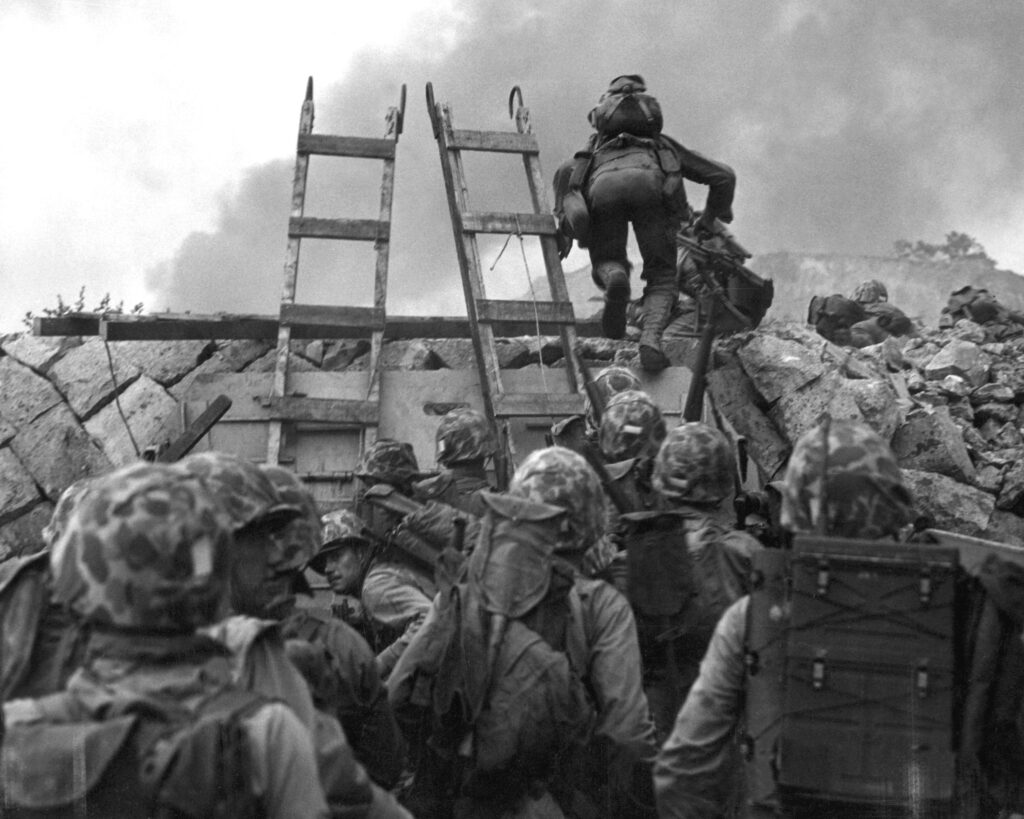
To take the pressure off the continuous attacks by the NKPA, a counteroffensive began on Sept. 15th, when United Nations forces made a daring landing at Incheon on the west coast. The unexpected attack crushed the meager NPKA defenses within a few days, cutting off North Korean supply lines to the south.
U.N. casualties during the Incheon landing and subsequent battles resulted in 566 killed and 2,713 wounded. In the fighting, the NKPA lost more than 35,000 killed and captured. As additional U.N. forces came ashore, they were organized into the US X Corps. Attacking inland, they advanced towards Seoul, which was taken on September 25th, after brutal house-to-house fighting. The daring landing at Inchon, coupled with the 8th Army‘s breakout from the Pusan Perimeter, threw the NKPA into a headlong retreat. U.N. troops quickly assembled and surged into the north after them.
The movement was fast, and by Oct. 19, the North Korean capital of Pyongyang was captured. By Nov. 24, NPKA were driven by the 8th Army, under Gen. Walton Walker, and the X Corp, under Gen. Edward Almond, almost to the Yalu River, which marked the border of Communist China. The successful advance north ended near the Yalu River when China’s People’s Volunteer Army (CPVA) entered the conflict by deploying approximately 250,000 Chinese troops in support of North Korea. Within weeks the combined Communist armies pushed the United Nations forces back south below the 38th parallel into a complete retreat.
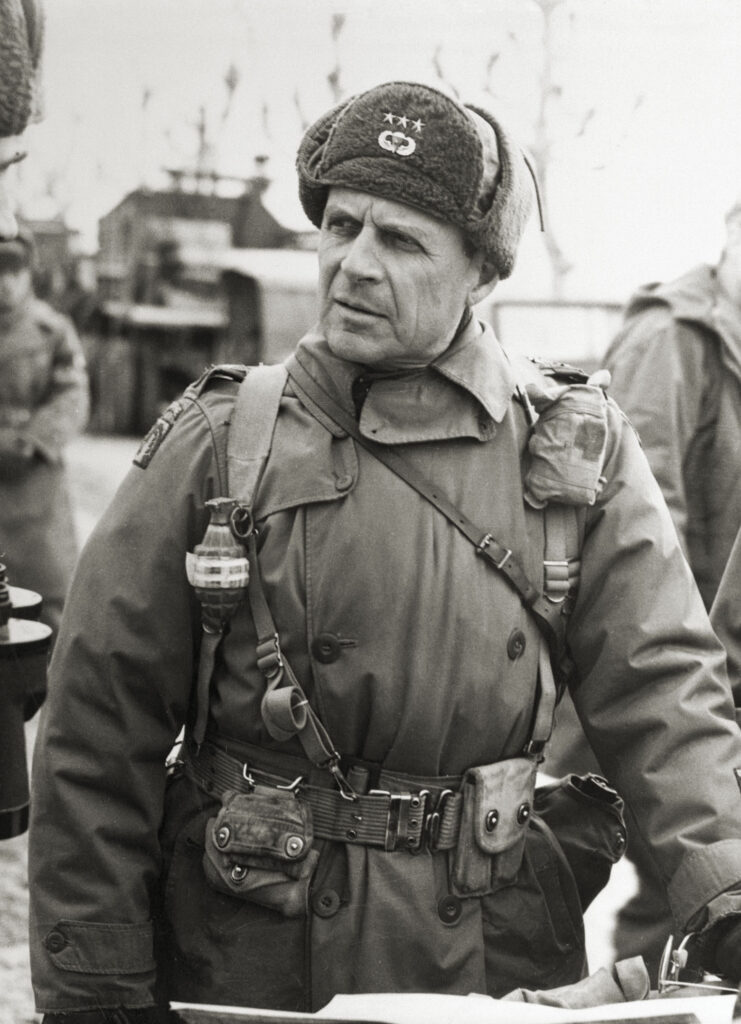
Just a few weeks after the disastrous defeat of United Nations forces in North Korea in late November 1950, Lt. Gen. Matthew B. Ridgeway, newly appointed 8th Army commander, issued orders to “seek, fix and kill,” as initial steps of Operation Thunderbolt, a forthcoming U.N. attack northward when troops of I and IX Corps advanced from the western sector of the front northward.
On January 29, 1951, a motorized patrol from the 23rd Infantry under the command of Col. Paul L. Freeman, Jr., was ambushed, bloodied and finally rescued after uncovering major outpost lines of the Chinese 125th Division at the Twin Tunnels, just three miles southeast of strategic Chipyong-Ni.
The Chinese Had Fled Up the Hills Toward Chipyong-Ni
Responding to Ridgway’s order to find and destroy the Chinese, Freeman’s 23rd Infantry, with the French Battalion de Coree attached, had moved in and, in a vicious two-day battle, brutalized three regiments of the Chinese division at Twin Tunnels. Defeated and in disarray, the Chinese survivors had fled up the hills toward Chipyong-Ni and beyond, where other Chinese divisions were preparing their own attack in answer to Operation Thunderbolt.
Shortly after the victory at Twin Tunnels, Ridgeway began his plan to reach the important crossroad village of Chipyong-Ni, located near the east-west center of South Korea, and to defend it at all cost. It was of immense strategic value because it was a key road intersection for all vehicular movement in the area southeast of Seoul. If overrun, a huge gap would open in the U.N. defenses that would severely threaten the flanks of an already shaken 8th Army.
A strategic thinker, he realized his ability to launch effective counter-offensive operations would be badly curtailed without control of Chipyong-Ni. Just forty miles north, the 38th parallel crossed the peninsula, generally marking the border separating Communist North Korea from free South Korea. Fifty miles west, twice-ravaged Seoul lay in Communist hands again, after the winter retreat of U.N. forces. Wonju located 15 miles southeast of Chipyong-Ni and in better times an important hub of communications and transportation was now a wasted, deserted city. Chipyong-Ni and Wonju were linked by a single-track railroad and a gravel road. Another town, Yoju, was situated about 20 miles south of Chipyong-Ni and connected to it by a gravel road; these three, in military-geographical terms, formed the Chipyong-Wonju-Yoju triangle.
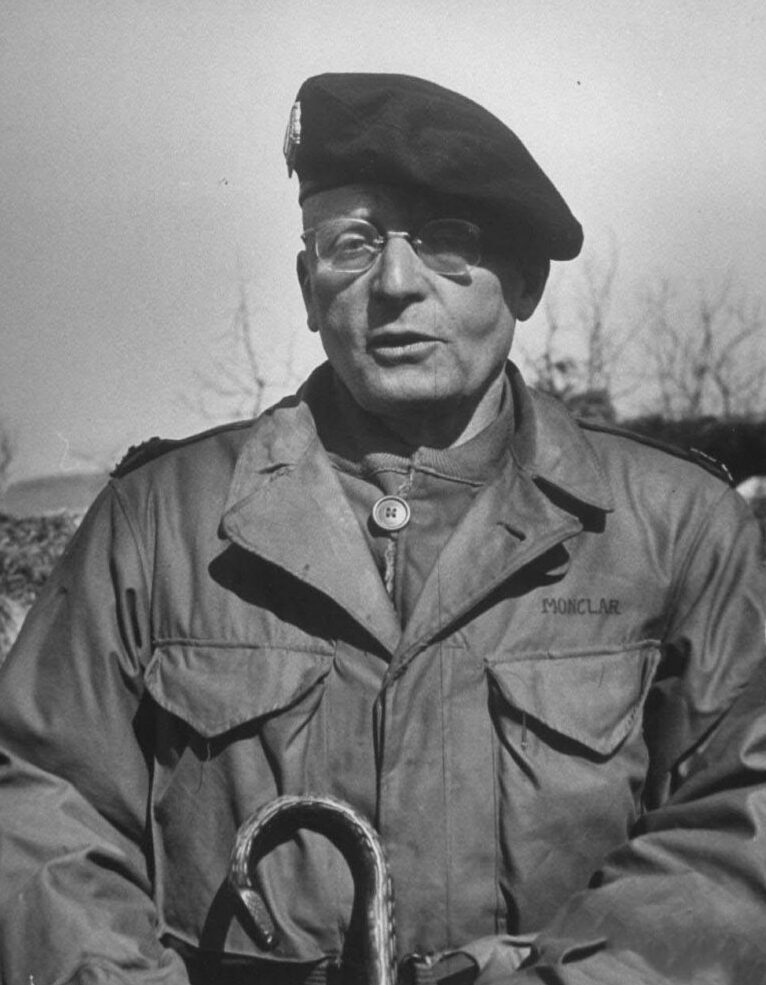
Ridgway needed someone to make a stand against the advancing Communist force to show the rest of his army that the Chinese were not an invincible foe. He knew the Chinese couldn’t sustain their attacks due to their dangerously overextended supply lines, so he turned to the men of the 23rd RCT, along with the attached French Battaillon de Coree, to be the ones to make that stand. History has since validated his choice of defenders – the 23rd had performed superbly early in the war in the Pusan Perimeter and had come through the Battle of the Chongchon River and Kunu-Ri relatively unscathed (one of the few units to do so). This had fostered an esprit de corps within the unit not often seen in those desperate days. Moreover, the Soldiers of the 23rd had a strong fighting spirit and were not lacking in confidence in their leadership. The French had also shown well at Wonju and Twin Tunnels; they were under the command of the larger than life figure Lt. Col. Ralph Monclar. This veteran Frenchman was already a national hero, a Three Star General at the time, but he voluntarily requested a demotion to Lieutenant Colonel to lead the battalion in Korea. Monclar fought in World War I, where he was wounded seven times and received eleven awards for valor. At war’s end, he was almost entirely disabled. In 1924, a fully recovered Monclar was selected for the French Foreign Legion, leading Soldiers in Morrocco, the Middle East, and Vietnam. During World War II, he fought with the French resistance from England. He was in his fifties by the time of Korea and was on the verge of retirement when he volunteered to lead his beloved battalion.
Late in the afternoon of February 3rd, the American-French force, only 70 percent effective after its losses at the brutal, bloody battle of Twin Tunnels, began the weary trudge, now unopposed, to the village of Chipyong-Ni. As they moved along under heavy packs of individual and combat gear, their infantry boots crunched through patches of icy snow, occasionally sidestepping frozen bodies of Chinese Soldiers.
As the column stretched along the snow-covered road to Chipyong-Ni, Freeman expected an ambush. He knew the Chinese leadership was bent on revenge because the hated 23rd Infantry had bloodied their noses previously at Kunu-ri during the winter retreat in North Korea and at Twin Tunnels a few days before.
Lt. Col. George Russell’s 1st Battalion Entered Chipyong-Ni
Freeman was a wiry, handsome, gray-haired Virginian who wore a full-colonel eagle on his helmet to distinguish him from the rank and file. He was known to be unpretentious, somewhat pessimistic. He often expected the worst to prepare for what was coming. He was occasionally profane when orders from higher-ups seemed inane or ill-advised. He had been Gen. Joe Stilwell’s supply officer during World War II, and a lot of Vinegar Joe had rubbed off on Paul Freeman. He would retire as a Four-Star General.
Following hours of marching, the advance guard of Lt. Col. George Russell‘s 1st Battalion entered Chipyong-Ni. Patrols encountered a few Chinese Soldiers, who fled after a few cursory rifle shots. The other two battalions of the 23rd, with the French Battalion, closed on the village later in the afternoon.
Freeman ordered a full alert. He realized that his 4,500-man force, including fewer than 2,500 front-line infantrymen, could not adequately man all the higher hills around Chipyong-Ni. Instead, he decided to install a rectangular-shaped perimeter on the lower hills immediately surrounding the village.
Over the next few days, they dug in and were reinforced by artillery, tank, and engineer elements. By February 13th, their strength consisted of three infantry battalions; the French Infantry Battalion and First Ranger Company, both attached to the regiment; the 37th Field Artillery Battalion; Battery B, 82nd Antiaircraft Artillery Automatic Weapons Battalion; Battery B, 503rd Field Artillery Battalion; Company B, 2nd Engineer Battalion (Combat); and a platoon from the 2nd Medical Battalion. In all, Freeman had 4,500 men under his command, including 2,500 front-line infantrymen.
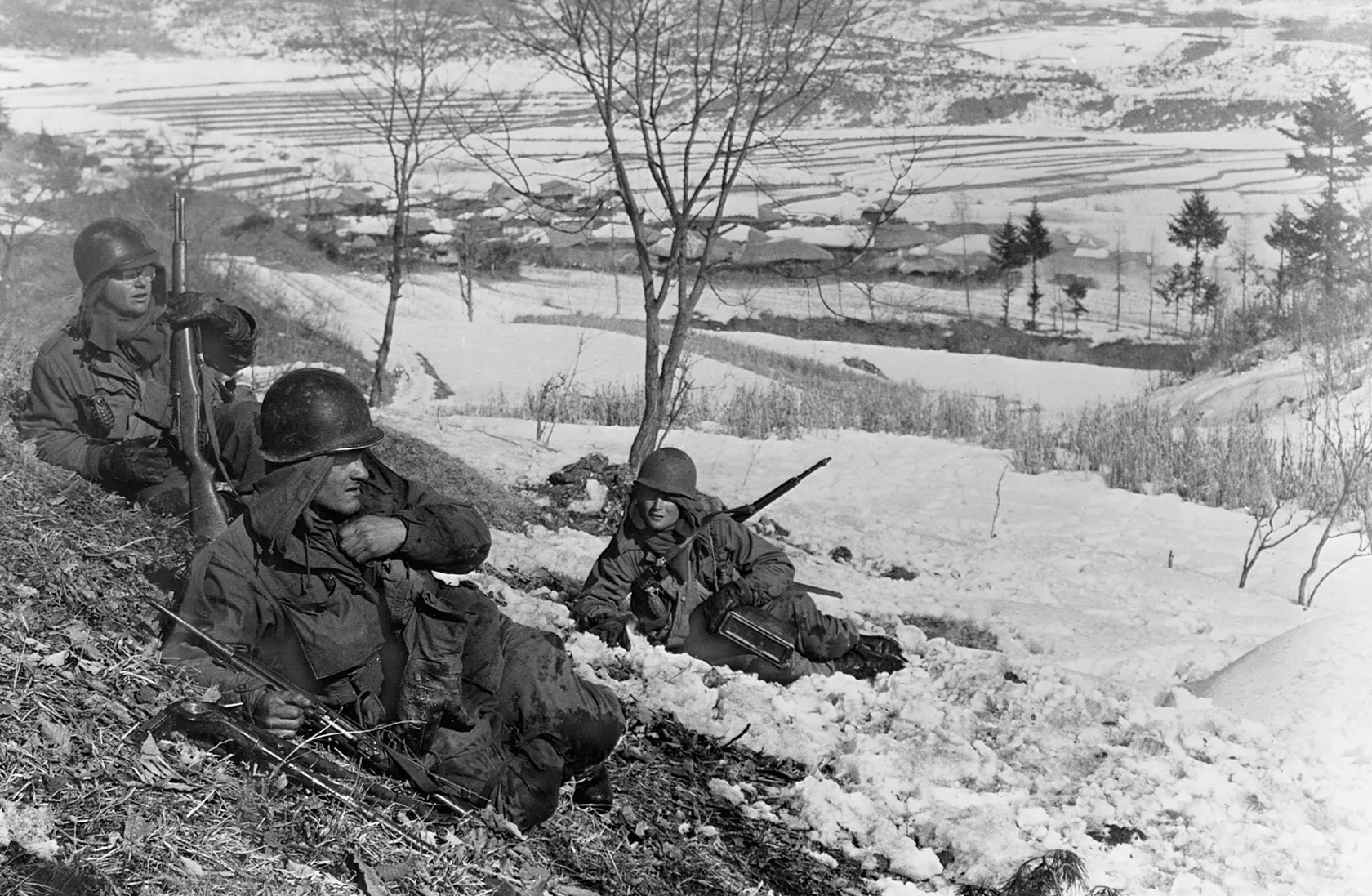
Once all positions had been prepared and fortified, Freeman outlined the mission to his officers: hold the small garrison against an advancing enemy force of five Chinese Communist Force (CCF) Divisions. Don’t count on reinforcements anytime soon – stand and fight it out, to the bitter end if need be. The men listened and accepted their lot. So be it. With quiet confidence Freeman’s charges prepared for the inevitable onslaught.
The exact size of the enemy force that lined up against the 23rd during the battle is unclear. Some sources put the attacking numbers as high as 25,000, while the Chinese claim they only threw 8,000 men into the fight.
But despite the heroics that Freeman’s and men Monclar’s performed, it could have been so much different had his request to withdraw been granted. Instead, they built up their defensive positions and rained down merry hell on the attacking units. The defensive line was then consolidated further as the commander began to undertake the work that would eventually repel the Chinese aggressors.
When you consider that the communist forces had the American and French troops surrounded, it makes their heroic and stoic defense of the village even more remarkable – and that’s exactly what happened as the light faded on February 13, 1951.
The Chinese Advanced on Chipyong-Ni From the South and East
Chinese were observed crawling, walking, and trotting around the railroad tracks, creek bed, road, and hills to the south. The supply road from Wonju was closing, as elements of the Chinese 40th and 66th armies shied away from Wonju and advanced on Chipyong-Ni from the south and east. Parts of the 39th and 42nd armies were closing in from other directions.
Aware of the growing Chinese movement around him, Freeman asked permission to withdraw. Eighth Army commander Gen. Ridgway said no. He planned to use Chipyong-Ni as a baited trap, enticing the Chinese to turn and attack it out in the open with large forces that could be destroyed by the combined firepower of the 23rd infantrymen, tanks, mortars, artillery, and close-in Air Force sorties.
Shortly before midnight, the deafening sound of whistles and bugles signaled the initial Chinese attack. This first attack was met and defeated by Monclar’s French battalion in close hand-to-hand fighting. The heroic French confused the Chinese raiders by cranking their own sirens before charging with fixed bayonets howling all the way, rattling the attacking Chinese so much, they turned and fled. The Battaillon de Coree will always be remembered for the legendary bayonet charge at Chipyong-Ni. The spirited defense set the tone for the rest of the defenders of Chipyong-Ni that night.
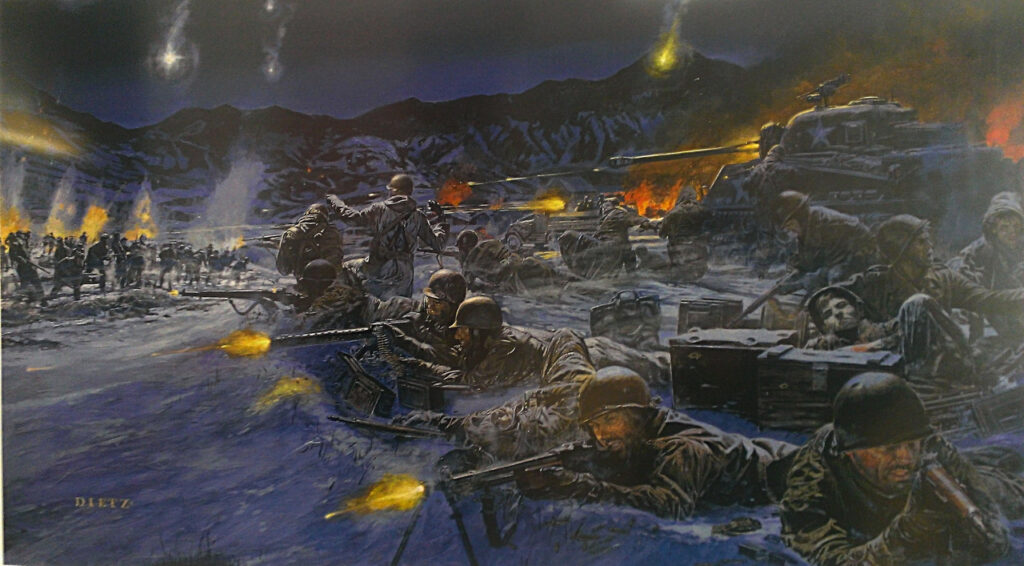
The Battle of Chipyong-ni Continued Into the Early Morning Hours
Elsewhere, throughout that first night, the Chinese attacked the perimeter again and again. Tasked with the defense of Hill 397, E and G companies detonated fougasse drums filled with gasoline and oil. As attackers got close to the drums, the defenders detonated grenades underneath them, spraying the Chinese with a deadly mixture.
As the battle of Chipyong-Nicontinued into the early morning hours, the fighting was fiercest against K Company. It was so bad that no ambulance could get to the front line in order to evacuate the wounded. Freeman had been wounded during the night, and the defenders had suffered about 100 casualties.
As dawn broke on February 14th, Valentine’s Day, the Chinese forces, fearing the devastating effects of daylight artillery and airstrikes, broke contact, withdrew, and prepared to resume the fight again the next night. A dusting of snow covered the communist dead in front of American lines.
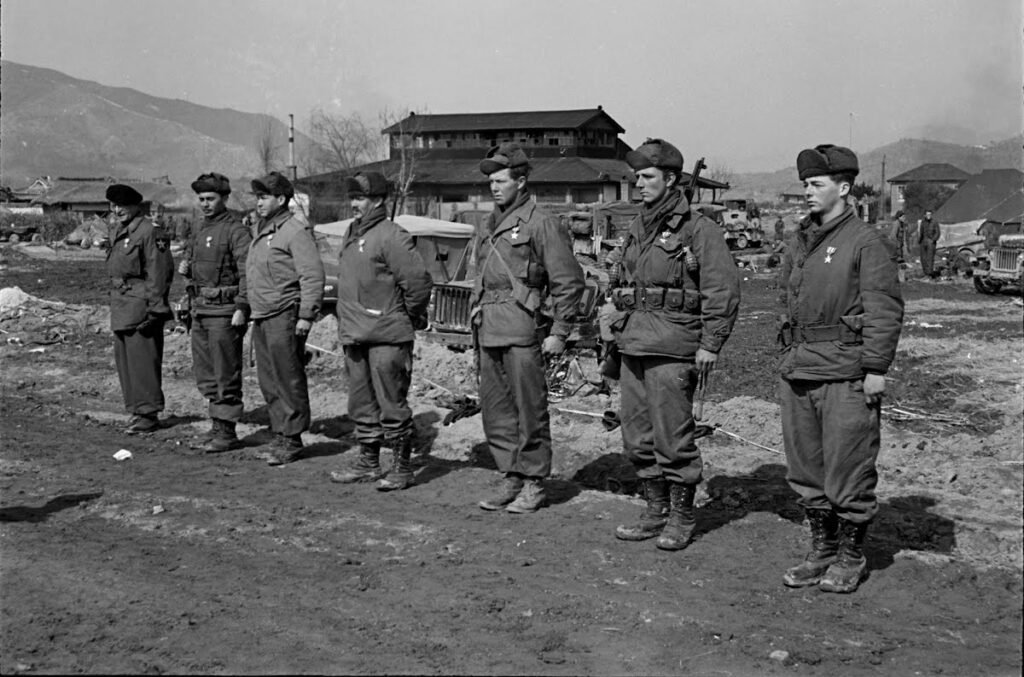
Later that day, Ridgway appeared suddenly in Chipyong-Ni. He toured the garrison and met with Freeman and his astounded troops, encouraging them to fight on. From most accounts, the Soldiers appreciated his visit and gained confidence from his presence. This was not the last time Ridgway would risk his life by dropping in on a battle zone unexpectedly. He walked the walk.
As was expected, soon after dark on February 14th, sirens, whistles, and howling echoed through the frigid night air and flames soared into the sky, signaling the beginning of another desperate night of fighting. Throughout that awful night, the Chinese launched repeated human wave attacks against the perimeter. Undaunted in the face of the savage and relentless raids, the French and American defenders refused to yield. Even when ammunition supplies were desperate, the men remained resolute. The fighting raged on fiercely until daylight finally broke on the morning of February 15th.
The light of day revealed a snowy battlefield littered with enemy dead; many were literally piled on top of each other in front of some positions. This had been brutal, hard, fighting. Once again, the Chinese attackers faded away into the hills for the day.
That morning the skies suddenly cleared for the first time during the siege – this was a great stroke of luck because it allowed for deadly airstrikes – napalm was dropped across the surrounding hills lay annihilating countless enemy troops. Cheers went up from the beleaguered ranks. The planes dropped loads of ammunition and food to the encircled fighters – things were looking up.
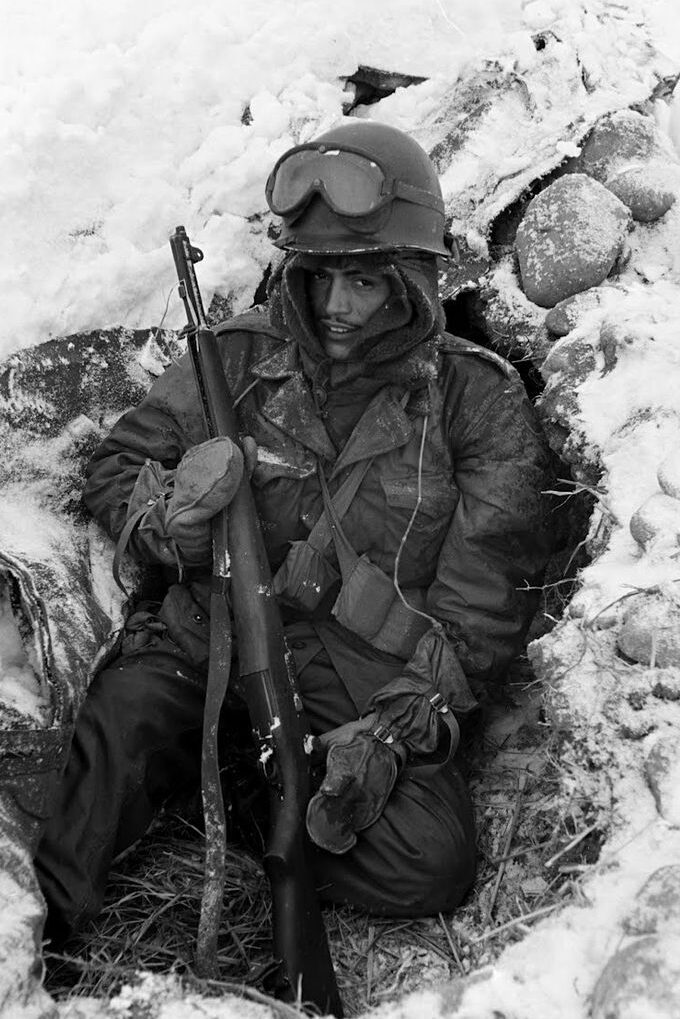
In the meantime, a relief convoy built around tanks from the 5th Cavalry Regiment had been fighting its way north through tough enemy fire, taking significant casualties to reinforce their valiant brothers in Chipyong-Ni. The arrival of the relief column, known to history as Task Force Crombez, coupled with the deadly strafing and napalm attacks sent the Chinese fleeing; they simply withdrew and disappeared from the area. With dogged determination, the defenders had finally broken the enemy onslaught. Ridgway had his victory.
The Battle of Chipyong-ni Marked a Turning Point in the War
The battle of Chipyong-Ni marked a turning point in the war; the victory resulted in the defeat of a massive Chinese offensive and caused the CCF to suffer its first tactical defeat at U.N. hands. This time it was the Chinese who were turned back, and they never again regained the momentum. The battle of Chipyong-Ni has since been referred to as the “Gettysburg of the Korean War.”
When it was said and done, the UN forces had inflicted heavy losses on attacking CCF units, but they too received many heartbreaking casualties – the 23rd suffered approximately 51 KIA, and hundreds more were wounded. Sadly, a number of men went missing in action at Chipyong-Ni. Enemy casualties were estimated to be in the thousands. Although the CCF fought on for another two and a half years, the battle of Chipyong-Ni permanently altered the direction and outcome of the Korean War.
The 23rd and their French allies stood strong despite long odds, vicious fighting, and traumatic casualties. While desperately fighting for their lives and for the lives of their brothers in the next foxhole, they unknowingly stamped their signature on the future. Their story, written 66 years ago in a snow-covered valley on the other side of the world, still resonates strongly all these years later. The victory at Chipyong-ni allowed the Eighth Army to survive and fight another day, the events that transpired there supplied the troops with a new fighting spirit and will to win – from this battle forward the Eighth Army only faced north. There would be no more retreating in Korea – just as Ridgway had ordered. The future survival of South Korea was all but assured.
Standing before a joint session of Congress more than a year later, in May 1952, General Matthew Ridgway stated: “I shall speak briefly of the Twenty-third United States Infantry Regiment, Colonel Paul L. Freeman commanding, [and] with the French Battalion. Isolated far in advance of the general battle line, completely surrounded in near-zero weather, they repelled repeated assaults by day and night by vastly superior numbers of Chinese. They were finally relieved. I want to say that these American fighting men, with their French comrades-in-arms, measured up in every way to the battle of Chipyong-Ni conduct of the finest troops America and France have produced throughout their national existence.”
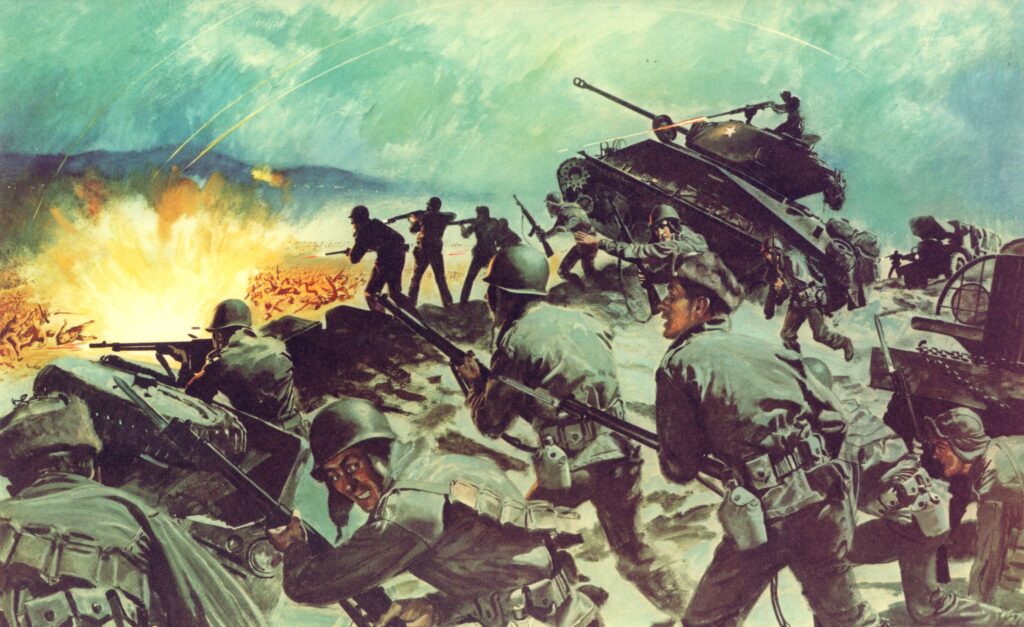
The Battle of Chipyong-Ni was a decisive battle of the Korean War that resulted in a United Nations Command victory. Due to the ferocity of the Chinese attack and the heroism of the defenders, the battle of Chipyong-Ni has been called “one of the greatest regimental defense actions in military history.”
This was a turning point, a pivotal, singular moment of the Korean War. Rising from the wintry ashes of defeat and humiliation, Americans had won a victory, and the myth of Communist invincibility was finally shattered.
Read About Other Battlefield Chronicles
If you enjoyed learning about the battle of Chipyong-Ni, we invite you to read about other battlefield chronicles on our blog. You will also find military book reviews, veterans’ service reflections, famous military units and more on the TogetherWeServed.com blog. If you are a veteran, find your military buddies, view historic boot camp photos, build a printable military service plaque, and more on TogetherWeServed.com today.

I was with the 223rd Infantry Bravo Company 1/23 Infantry October 1975 to November 1976. Our unit went to Chip Yong NI to commigrate that battle. . I felt pride in my unit knowing that 23rd and French soldiers had defatted the Communist aggressors there. We spayed up on the hill where B 23 Infantry had been positioned during the battle. The next day we marched to a school yard where Korean Dignitaries and some High Rankin Korean Army Officers greeted us. and made some comments about the sacrifices the 23rd made during the Battle.